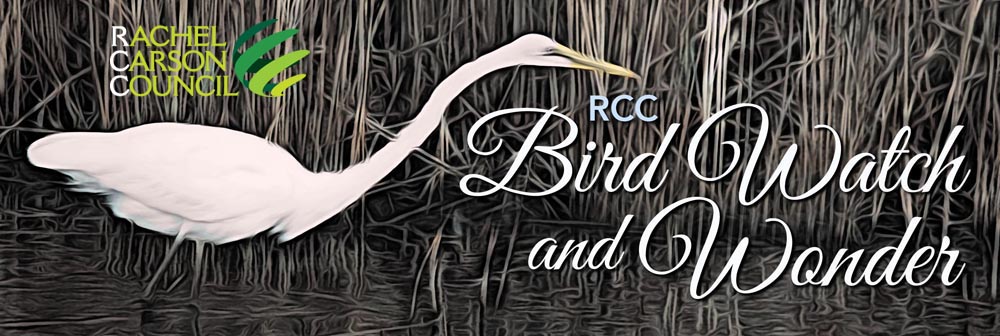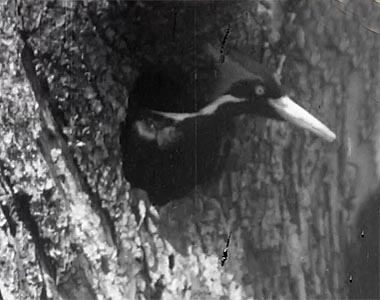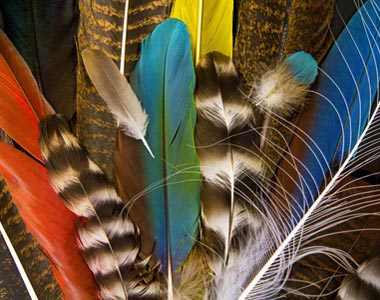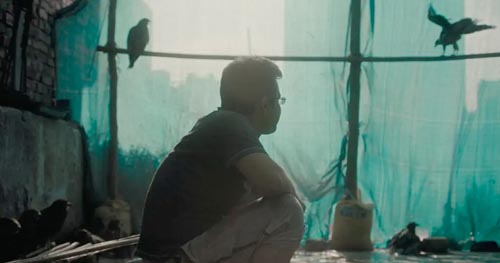 | | |  Perhaps the biggest recent bird story in this January issue of RCC’s Bird Watch and Wonder is about renewed reports of sightings of the legendary and long-thought extinct Ivory-billed Woodpecker. Steve Latta of the National Aviary in Pittsburgh and others who say they have seen the “Lord God Bird” in the remote, swampy woods of Louisiana are trying to get the U.S. Fish and Wildlife Service to remove it from the list of extinct birds. They hope naming the Ivory-billed as a living, endangered bird will help protect and prevent the development and degradation of its habitat in hard-to-access woods. Perhaps the biggest recent bird story in this January issue of RCC’s Bird Watch and Wonder is about renewed reports of sightings of the legendary and long-thought extinct Ivory-billed Woodpecker. Steve Latta of the National Aviary in Pittsburgh and others who say they have seen the “Lord God Bird” in the remote, swampy woods of Louisiana are trying to get the U.S. Fish and Wildlife Service to remove it from the list of extinct birds. They hope naming the Ivory-billed as a living, endangered bird will help protect and prevent the development and degradation of its habitat in hard-to-access woods. But remote Louisiana woods are not the only places for birders that can be inaccessible. Check out Tara Lohan’s report, “Birding for All,” on the birder and accessibility champion, Freya McGregor, who watches birds from her wheelchair. McGregor is a consultant to refuges, parks, and other birding spots to help them make even simple changes like low guardrails that allow for good viewing while seated, ramps, benches, and accessible boardwalks. McGregor also helped, with the Audubon Society, to create the Birdability Map. It lets you check out in advance the accessibility of birding sites nationwide.  Our January issue, of course, includes in “Bird Lore” the latest musings of Ross Feldner on the marvelous and colorful world of bird feathers. We are also launching two new features that highlight our pick of reader favorites during the month. “The Best of Bird of the Week” begins with our national symbol, the Bald Eagle, while the “Best of Momentary Mediations” showcases the top offering this month from Stephen Shick’s weekly and evocative short videos and insightful reflections. So, if you missed it before, be sure to wonder at the amazingly costumed Harlequin Duck. Our January issue, of course, includes in “Bird Lore” the latest musings of Ross Feldner on the marvelous and colorful world of bird feathers. We are also launching two new features that highlight our pick of reader favorites during the month. “The Best of Bird of the Week” begins with our national symbol, the Bald Eagle, while the “Best of Momentary Mediations” showcases the top offering this month from Stephen Shick’s weekly and evocative short videos and insightful reflections. So, if you missed it before, be sure to wonder at the amazingly costumed Harlequin Duck. | | | | | | | | | | | | This Bird is Extinct, the Government Says. Not Everyone is So Sure. A bevy of amateur birders and professional ornithologists is racing to prove the ivory-billed woodpecker still exists, before federal officials remove it from the endangered species list Steven Latta was trudging through the wet bottomlands of Louisiana when he spotted it: A flash of “brilliant white” rising toward the sky. To him, the sight was unmistakable: It was the black-and-white plumage of an ivory-billed woodpecker. | | | | | | Harsh Mountain Winters Have Made Chickadees Smarter A decade of research has revealed how the cognitive abilities of chickadees are shaped by their surroundings. Now scientists have begun to peer inside the black box of genetics, uncovering the variations in the birds’ DNA that made these adaptations possible. It’s January in California’s Sierra Nevada mountains, and scientist Carrie Branch is on snowshoes, trudging uphill through several feet of fresh powder. Her destination is a backcountry bird feeder in the Tahoe National Forest, accessible only by driving up six miles of forest roads and then bushwhacking in. | | | | | | In a First, Hawaiian Petrel Chick That Hatched at a Predator-Free Site on Kaua‘i Takes Flight The fledgling gives conservationists hope that Endangered Hawaiian Petrels will establish a thriving colony within the fence-protected area of Nihokū. For 10 years, a consortium of partners* led by Pacific Rim Conservation and the U.S. Fish and Wildlife Service and supported by American Bird Conservancy (ABC) have worked at Kilauea Point National Wildlife Refuge on Kaua‘i to establish a predator-free colony of Endangered Hawaiian Petrel (‘U‘au) in a bid to save the species from extinction. | | | | | | This 120-Million Year Old Bird/Dinosaur Hybrid Is Teaching Us How Birds Came to Be A bizarre cross between a bird and a dinosaur had blue, brown and grey feathers, a long tail, and small teeth. What’s more, their brain morphology is perfectly transitional between bird and reptile, with a brain likely built to smell like reptiles, but also to see well in daylight like birds. Jeholornis lived 120 million years ago, and recently scientists have digitally-reconstructed its skull for the first time at the Field Museum in Chicago. | | | | | | | | The Marvel of Bird Feathers "Fine feathers, they say, make fine birds." This quote from 18th century Irish poet Isaac John Bickerstaff reminds me of the feeling of wonder I get when finding a bird feather, examining the complex structure, the beautiful colors, and patterns. A bird feather is a marvel in so many ways. While touching feathers is okay, some feathers are federally protected under The Migratory Treaty Act of 1918. Birds are not the only creatures on earth that can fly, but they are the only one with feathers and hollow bones that make them lightweight and yet still strong. | | | | | | | | The Record-breaking Bird That Flew From Alaska to Australia Without Stopping Staring at the sky, have you ever wondered where all the birds fly to? Whilst some migrations are short, others travel across vast distances. For migrating birds, a missed turn can prove to be fatal because they spend several weeks flying over oceans and continents from one end of the planet to another. However, in 2022, one juvenile bird successfully earned a place in history with its unexpected turn. | | | | | | | | Birding for All: How to Make Enjoying Birds More Accessible Disability is too often left out of the conversation about equity and inclusion in the outdoors. We can change that. A broad definition of birding makes for a more inclusive community. So too, does attention to accessibility needs. McGregor knows this well — she’s a birder with a disability. She’s also an occupational therapist who works with people with blindness and low vision. And she runs a consulting company, Access Birding, that helps train staff and volunteers at nature organizations and public lands to improve access and inclusion for birders with disabilities. | | | | | | Life Is Hazardous for Urban Raptors. These Women Offer Hope. It’s quiet on the back roads of Boyds, Md., where a small compound studded with bird feeders breaks up the monotony of the surrounding cornfields. Suddenly, a souped-up Toyota Tacoma kicks up a cloud of dust as it pulls into view on a gravel path. It slows to a halt. A figure steps out of the truck: a woman with a glove covering one arm and a sleeve of hawk tattoos covering the other. Reaching into the passenger seat, she pulls out a box, one that seems to be fighting her back. This one, I knew, would be headed for the I.C.U. | | | | | | Advances in Window Safety Come to the Cornell Lab and Cornell Campus Every year, up to one billion birds die from window strikes in the U.S, species of all sizes brought down by the invisible tragedy of glass. A growing body of research surrounding the severity of window collisions—and ways to avoid them—has resulted in more organizations moving toward bird-friendly buildings, including the Cornell Lab of Ornithology. | | | | | | | | Bald Eagle Our nation’s symbol is the Bald Eagle, which is not really bald; it has white feathers on its head, neck, and tail. The word bald in the eagle’s name comes from a derivation of balde, an Old English word meaning white. This majestic bird is a diurnal (day) hunter that can swim, fly 20-40 miles per hour in normal flight, and dive at speeds over 100 miles per hour. Eagle nests are very large, often used year after year, adding more twigs and branches each time). One nest found had been used for 34 years and weighed over 2 tons! | | | | | | | | No Harlequin Fools Rough coastal rocks were their stage. Yet, naming these ducks Harlequin seemed a distraction from the seriousness of their struggle to survive and thrive in the often seriously polluted Northeast coastal waters. | | | | | | | | Once an Open Sewer, New York Harbor Now Teems With Life. Thank the Clean Water Act. Fifty years ago, Congress voted to override President Richard Nixon’s veto of the Clean Water Act. It has proved to be one of the most transformative environmental laws ever enacted. At the time of the law’s passage, hundreds of millions of gallons of raw sewage was dumped by New York City into the Hudson River every day. This filth was compounded by industrial contaminants emptied into the river along much of its length. | | | | | | The Weedkiller Dicamba Is Poisoning Wildlife Habitat. Will the EPA Finally Act? Blamed for destroying crops and fraying community ties, the widely used herbicide also poses a threat to the plants birds Midday, mid-June, mercury in the mid-90s. On the Arkansas Northeastern College campus in Blytheville, Dan Scheiman peers through binoculars at a big oak. Robins and cardinals flit nearby, but it’s not a bird that’s caught his eye. Something is wrong with the tree. He marches over for a closer look. The leaves are curling inward, an abnormality called cupping. “Top to bottom,” he observes, circling the trunk. | | | | | | | | Gallery: Embroidered Birds for the Eye and Ear Brazilian sound recordist Ana Luiza Catalano has archived nearly 300 audio recordings of birds in the Cornell Lab of Ornithology’s Macaulay Library, thanks to training she received from taking the Cornell Lab’s Sound Recording Workshop twice. Catalano earned her PhD researching birdsong, and she conducts acoustic monitoring of bird populations in the Amazonian forest. | | | | | |  | | | ‘All That Breathes’ Review: Hope Is the Thing With Feathers  Shaunak Sen’s poetic documentary chronicles the efforts of three New Delhi men to help the city’s birds of prey. Shaunak Sen’s poetic documentary chronicles the efforts of three New Delhi men to help the city’s birds of prey.
The first shot of “All That Breathes” explores a vacant lot at night, tracking rats and feral dogs through puddles and piles of refuse. Your instinct might be to recoil from a tableau of urban squalor, but there is a quiet, rapt attention in the images that suggests a different response. Even in the clogged thoroughfares and crowded neighborhoods of big cities like New Delhi, where this remarkable documentary unfolds, we are closer to the wildness of the natural world than we might suppose. The three principal human characters in Shaunak Sen’s film have devoted their lives to caring for black kites, birds of prey almost as unloved in Delhi as scavenging rodents and canines. Wounded kites and other raptors, excluded from a local avian hospital because of their nonvegetarian ways, find their way to Wildlife Rescue, a small clinic that doubles as a workshop for the assembly of soap dispensers. There, Nadeem Shehzad and Mohammad Saud, the brothers who founded Wildlife Rescue, work with their associate Salik Rehman to rehabilitate the birds until they can return to the skies. Their efforts on behalf of the kites were the subject of an article in The New York Times in 2020. The methods of “All That Breathes,” which mentions that piece, are more impressionistic than reportorial. There is something inherently mysterious about birds and their interactions with people, and also something unmistakably spiritual about Wildlife Rescue’s devotion to their well-being. Read more Click here to watch the trailer | | | | | | The January 2023 issue of Bird Watch and Wonder was produced by Ross Feldner. | | | | | |  The Rachel Carson Council Depends on Tax-deductible Gifts From Concerned Individuals Like You. Please Help If You can. The Rachel Carson Council Depends on Tax-deductible Gifts From Concerned Individuals Like You. Please Help If You can. | | | |  Sign Up Here to Receive the RCC E-News and Other RCC Newsletters, Information and Alerts. Sign Up Here to Receive the RCC E-News and Other RCC Newsletters, Information and Alerts. | | | | | | | | | | | |